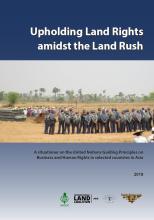Land Library Search
Through our robust search engine, you can search for any item of the over 73,000 highly curated resources in the Land Library.
If you would like to find an overview of what is possible, feel free to peruse the Search Guide.
/ library resources
Showing items 1 through 9 of 66.The Rio Platano Biosphere Reserve (RPBR) extends over 832 thousand ha in the Mosquitia Region of Honduras, and is one of the most important protected areas of the Mesoamerican biological corridor.
Despite the progress made in terms of global and national land policy frameworks, effective changes in practices remain limited.
The land rush has remained, and is likely to remain, a significant global phenomenon despite waning international media attention. The scope of the phenomenon is likely to be wider than previously thought.
This publication discusses the relevance to land and agriculture of the United Nations Guiding Principles on Business and Human Rights (UNGP BHR), and provides an overview of the state of the UNGP BHR’s implementation in Bangladesh, Cambodia, India, Indonesia, Nepal, and the Philippines.
The International Land Coalition’s Commitment 8 seeks to ensure transparency and accountability, through unhindered and timely public access to all information that may contribute to info
Over the last decade, there have been considerable concerns raised regarding the social and environmental impacts of large-scale land concessions for plantation development in various parts of the world, especially in the tropics, including in Laos and Cambodia.
WEBSITE ABSTRACT: This case study presents a country-wide quantitative analysis of a Parliamentary Commission established in 2012 in Myanmar to examine ‘land grab’ cases considered and to propose solutions towards releasing the land to its original owners, in most cases smallholder farming famili
Since small-scale farmers manage most of the cultivated land worldwide, the ongoing shift in systems of production associated with large-scale land acquisitions (LSLAs) may dramatically reshape the world's agrarian landscape, significantly impacting rural populations and their livelihoods.
ABSTRACTED FROM CHAPTER INTRODUCTION: The preceding chapters of this book give a central place to the Powers of Exclusion framework for understanding transformations in land relations, as developed in our 2011 book on Southeast Asia.






